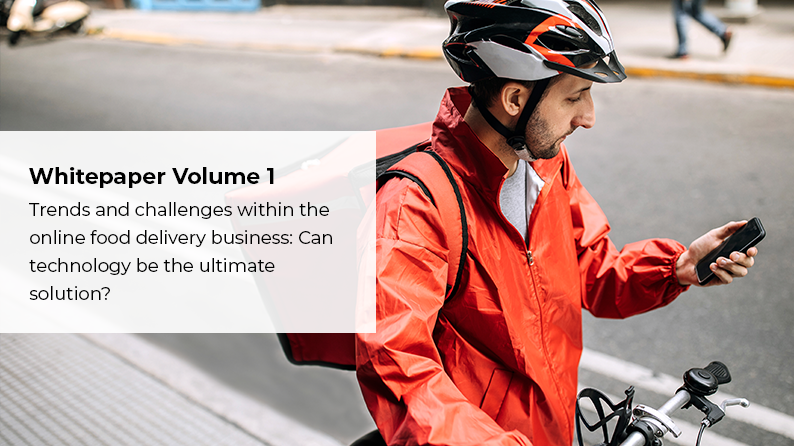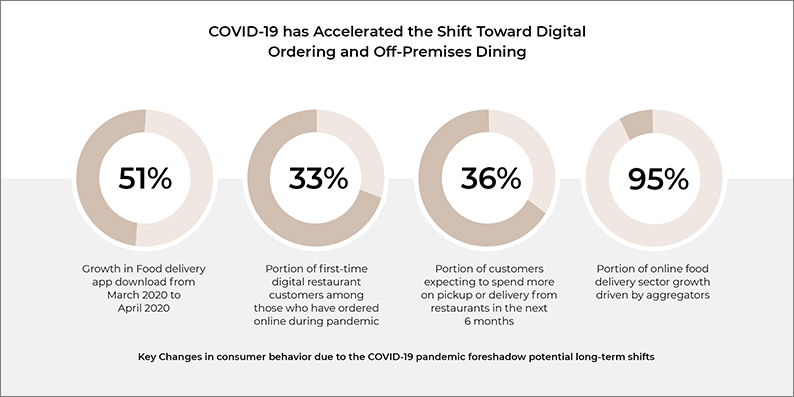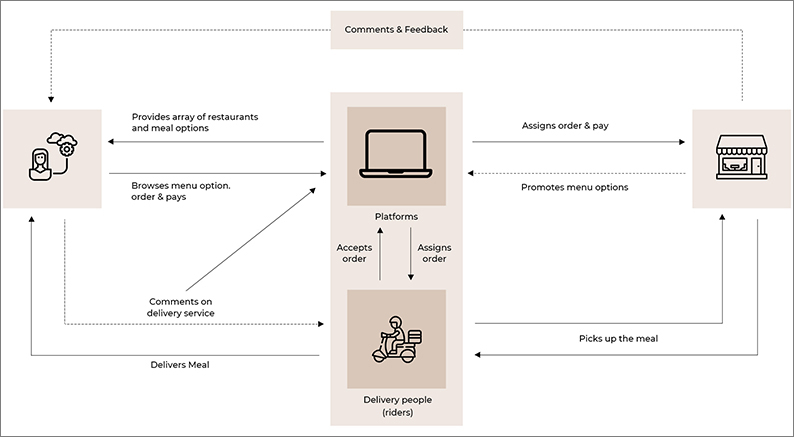Whitepaper Volume 1
Who should read this Whitepaper?
Are you a foodpreneur, or owner of a restaurant looking to add an additional service channel, or simply wanting to re-platform from your existing portal? If yes, then expert opinion from within the industry will contribute immensely towards important business decisions.
Setting up an online business in the food industry today is probably one of the most satisfying from a market demand point of view, and yet among the most challenging, considering the difficult scenarios related to health and safety. Thoroughly planned business models can however prove to be financially rewarding and high on customer satisfaction at the same time.
Through this series of whitepaper we will address some of the most prevalent of the challenges that business owners setting up their online food delivery are confronted with. We try to collate solutions for those venturing in this domain, to help them sustain an efficient and gainful online food delivery business.
In this Volume 1, we shall be covering the background as well as the business trends in the food industry.
Background
The food business has transformed substantially with changing times. Gone are the days when only one restaurant in the city was serving chinese food, and families and friends booked their weekends to relish their favorite chinese dishes. With the advent of the digital in all spheres of our lives, the food industry has picked up momentum to match up with consumer progress.
i. Revolution in the food industry
Calling the changes happening in the food sector, a revolution, means we realize the drastic and dramatic events within the domain that happened simply to stay afloat, and in sync with the new consumer in the new normal.
Food technology pioneered the revolution with new improved varieties of crops being introduced as a result of research and technological innovations. The revolution within the food value chain spread from raw materials, to ready meals being home delivered. With every aspect of the chain upgrading itself with digitalization, food went from being tasted to being read online.
Platforms and applications today are able to display restaurants around the city/area with descriptive details on each dish or food item, enabling easy ordering through mobile devices. In simple words, food e-commerce was born to sustain restaurants and food businesses amid the market turbulence.
Evolution of the Development Landscape: The real revolution is however happening right now. A walk through the evolution in the food value chain will shed some light on the events in the journey so far.
- 753 B.C. to 476 A.D. – Thermopolium (fast-food-restaurants) in ancient Rome, for hot prepared meals on the go.
- 1785 – Milk Delivery began with the rise of industrialization
- 1889 – Pizza Delivery began with the first delivery to King Humberto & Queen Margherita
- 1890 – India Introduced the dabbawala meal in Mumbai, 125 years ago, delivering directly to the places of work.
- 1939 – 1945 – Delivering food during WWII to people and veterans, spreading the food delivery popularity to the United States and Australia.
- 1950s – With the Television being invented, restaurant dining declined, and home delivery of food and pizza popularized.
- 1954 – Voluntary food distribution to the needy – introducing food on wheels
- 1960 – Present – The concept of food trucks began and is common till date
- 2004 – Present – Meal delivery began with players offering logistical services to restaurants
- 2007 – Present – Blue Apron and Marley Spoon begin meal kit deliveries to cook recipes at home
- 2013 – Present – Companies like Factor enter the market and start delivering fully prepared meals taking less than 3 minutes to cook.
- 2019 – Present – Skyrocket Demands for cooked meals delivered straight to the doorstep
- 2021 and ahead into the future – Autonomous food delivery with personal delivery robots and self-driving cars.
The pandemic has been a huge contributor that has led to restaurants and foodpreneurs improvising in ways never thought of, leading to a new outlook for the food ordering and delivery segment.
The pandemic – a propeller
Believe it or not, the COVID-19 pandemic has shrunk the world into a small space. People and businesses have unknowingly, even though just virtually, gotten closer in coming out victorious against the unfortunate events. Amidst rise in business within different sectors, food delivery is one which has seen exponential growth.
The pandemic pushed restaurants to keep supplying in times of most need. Which began as services to those who couldn’t cook and were living alone, transcended to almost every household. As people were locked inside, unable to move out for any entertainment, ordering food became the only luxury available.
This growth, if observed from 2 points-of-view show the positive impact on the industry as a whole:
- Due to the surge in demand, companies have augmented their services and are trying their best to offer improved delivery services. Where customers have the freedom to customize their choices and order anything they want, growth is imperative.
- Looking at the situation from a business angle, these demands create a competitive drive among different suppliers to better their offerings and upscale their business. In order to become better than each other, the industry as a whole is more creative today.
With such growth, revenue is bound to improve, giving a positive push to the food ordering and delivery industry. Platforms for food ordering and delivery have become the face of these companies, and the major source of revenue. The maturity in these platforms is again something that happened with the huge demands pouring as the COVID-19 wave hit the world.
Overall, the pandemic has been able to offer a positive impact on two major components, contributing to the rise in the online food ordering and delivery sector:
- Frequency of food orders being made
- Spending level for food
The online food delivery sector has thus efficiently and successfully been able to cultivate favorable food habits along with developing entirely new markets, making the best use of the opportunity at hand.
As we move deeper into understanding the online food segment we get a clear picture of the existing scenario. The trends within the sector play a major role in building the market and defining the future. A look into the food business trends will help identify potential areas of growth and expansion.
Food Business Trends
The business trends in the food industry have been largely driven by conditions precipitated by the pandemic. The online sales of food along with groceries saw a massive increase of 125% in the past 1 year. The way lifestyle changed and the way people began to explore different ways of availing facilities while at home, pushed the food industry to explore newer boundaries.
What began as food technology is now stretched to technology-assisted food delivery. From improvising food raw materials for better versions to delivering completely cooked meals to customers merely through virtual platform-based interactions, technology has played a major role in defining the current format of food businesses.
Food production, in-line with the technological advances will however always face the wrath of environmental factors. The progress there will, in some way or the other, always be affected by uncontrolled parameters. Yet technology has, to a massive extent, overcome the low productivity and food scarcity problems.
Innovation in business models in the food domain however, is something that has contributed to the adapting and changing world around us.
i. What is the present
At present, food businesses have been the most prompt in responding to a raised bar of expectations and demand. With the world going mobile, the restaurants and food outlets began a new communication channel along with home deliveries, being able to connect with the restaurants through various mobile modes.
The current trends include the changes that happened since the uprise of e-commerce and penetrated the food business, as well the factors related to the COVID-19 that have led to an exponential growth in technology assisted food delivery.
So, ‘the present’ in the food business are smart platforms that harbor exhaustive options for a customer to choose from and order. An online place where restaurants, dishes, and options to customize are plentiful, as per the day, weather, occasion, or even mood. With suggestive insights on what can be created to intelligent memory helping recall the favorites, a good platform for relishing delicious dishes while being anywhere is just the thing of the present.
The key role players that play a part in the success of this value chain are:
- A customer who searches for or creates a demand for online food ordering.
- The restaurant or food business owner who sets up the online channel, offers food, and its delivery online.
- Technology partners who help develop a system that connects stakeholders through virtual channels.
- Delivery personnel who build the logistics of the entire online food delivery business
Today, the dynamics between these 4 need to be absolutely balanced in order to make this system run. The business owner is thus always looking for new ways to keep the customers demanding for more, and remain operational. Since generation Y is hooked depending on the experience it keeps getting, subscriptions are trending compared more to one or full-time purchase.
Technology has made possible almost every little activity happening within the domain of food ordering and delivery. So the present is driven by technology from searching for a restaurant, a dish, to ordering, paying for it, tracking its route, and leaving a feedback or review on the product.
Yet, it seems there is more to come, and lots to be discovered in times to come. As more and more consumers get addicted to a device-dependent lifestyle, upcoming trends in the food business seem promising.
ii. What’s to come in the future
The future of the online food industry is somewhat an amalgamation of limitless offerings with overwhelming convenience hurled by customer choices and desires. With a tech-driven present, the future is bound to be steps ahead.
Some of the significant technological artefacts that can be expected to build the future of the food business revolve around understanding the consumer through behavioral and predictive analytics.
The future trends will focus more towards customer satisfaction, and meeting the consumer where they are in their journey of technological maturity. Different segments where advancements have started happening will guide ahead for further progress.
Channels facilitating online food delivery
With mobile applications ruling the trends today primarily because of the seamless connectivity and convenience of operations, new channels are expected to develop on this to redefine online food ordering:
- Ordering via a tweet
- A virtual assistant receiving orders and organizing delivery
- Placing orders by smartwatches
- The TV as an interface to place online food orders
- Reading eye movements and deciphering customer preferences
- Enabling ordering from the car
Delivery Resources
As ordering will gear up and improvise with technological integrations and innovations, restaurant and food business owners will utilize the best of inventions to take customer experience to the next level. Various delivery resources will enter the value chain to add a zing to the whole process of online ordering:
- Robots for delivery – Robotic food delivery is out in the streets creating a niche. DoorDash has deployed robots in cities with expectations of immediate or scheduled deliveries. The robots are taking less of street space, offering streamlined deliveries without any competition to vehicles on busy streets.
- Self driving cars – UDI introduced self-driving cars into actual application in China during the lockdown. Considering they really covered for lesser worf-force during the pandemic, keeping food delivery businesses in order and meeting market demands, the self-driving cars seem to hold a promising place in the food delivery industry.
- Drones to drop off food packets – AHA and Flytrex launched drone delivery way back in 2017, and Flytrex is testing food delivery via drones in California now. With extension to e-commerce, drones have presented the delivery industry with a next-gen source of meeting demands of delivering goods out of the traffic way.
- Parachute facilitated delivery of food – Jafflechutes are delivering packets of food to Australian customers at the Noms Away restaurant. With a few roadblocks that could disturb the flow to be sorted, the creators are in the process of bringing it to New York streets for a bigger test.
New Niches
‘Embracing the new’ is surfacing as the trend and is expected to stay for times to come. It can be anything new and different that might be able to control the market:
- Apps to manage food wastage – With huge amounts of food being wasted by suppliers, retailers, and consumers, technology-assisted solutions like Neighborly are helping solve this problem by bringing together both the donors as well as the recipients.
- Apps for pet food – Dedicated apps that provide home delivery of different food types for any kind of pet.
- Virtual kitchens – Providing additional revenue sources to small restaurants, allowing them to offer more items under separate restaurants which are listed only on online platforms. Saving on infrastructural investments they are helping them with better revenue, generating more capital for growth in their business.
- Meal Delivery – The pandemic broke many barriers between people who enjoyed cooking. The internet helped them exchange recipes to new dishes, and ordering for set requirements cropped up as a trend. Companies picked up the demand and delivering a fixed set of ingredients for a meal to be cooked has risen as a new niche within the food delivery segment.
AR and VR
Augmented and virtual reality as technology have come a long way with applications in multiple fields. Increasing the vision and bringing the virtual closer to the real has added multiple benefits in areas from medicine research, education, to virtual or online shopping.
In areas of food delivery, AR/VR have been put to intelligent use with advertising and training for various processes. Also, customers are given an experience through apps that they are looking at the actual dish, so as to ascertain their choices.
Making virtual seem closer than real, people have as a result started showing more trust in food companies delivering to the doorsteps.
Big Data for Improved Services
The data harnessed is seldom put to appropriate use. Food companies and others have now begun realizing the gold mine they are sitting upon with all the data. Entire data sets are capable of providing immensely precious insights that could take business owners to new heights.
Different databases like traffic data, temperature and weather, customer purchase history, and market trends can help food businesses plan better for efficient and unstoppable services at all times.
Generating Smart Investments
Gathering investment for a new food business to match up to the upcoming trends can be a daunting task. Convincing investors to pour their money into the future requires brilliant predictions to be made with solid references that ascertain benefits with decisions taken today.
Working on customer feedback and suggestions, as to what they would want out of their favorite food delivery service, they could be asked to pitch in small amounts to get the ball rolling. Crowdsourcing has led to many accomplishments, and has provided communities with outcomes they desired.
This seems to be a lucrative way food businesses might be thinking about. With a promise to give back, a small affordable amount in favor of building a business model of their interest, will attract their loyalty too.
Summarizing, data will serve as the focal point to optimize operations as well as predict customer demands. Investing into smart software will enable better inventory, delivery, and resource management, and future oriented food business models will keep the market occupied.
What food business models rule the industry today and the challenges they face, will prominently be able to decide the fate of online food businesses of tomorrow.
As the focus of this whitepaper is to understand and address the challenges existing within the online food industry, we shall explore the popular business models that actually contribute to the majority of the current market in the second part of the post. Stay Tuned for the next part to learn about the business models, demand and supply, major challenges, and potential solutions to fill in the gaps.
Visit white paper Volume 2 for further details on food delivery business market.



